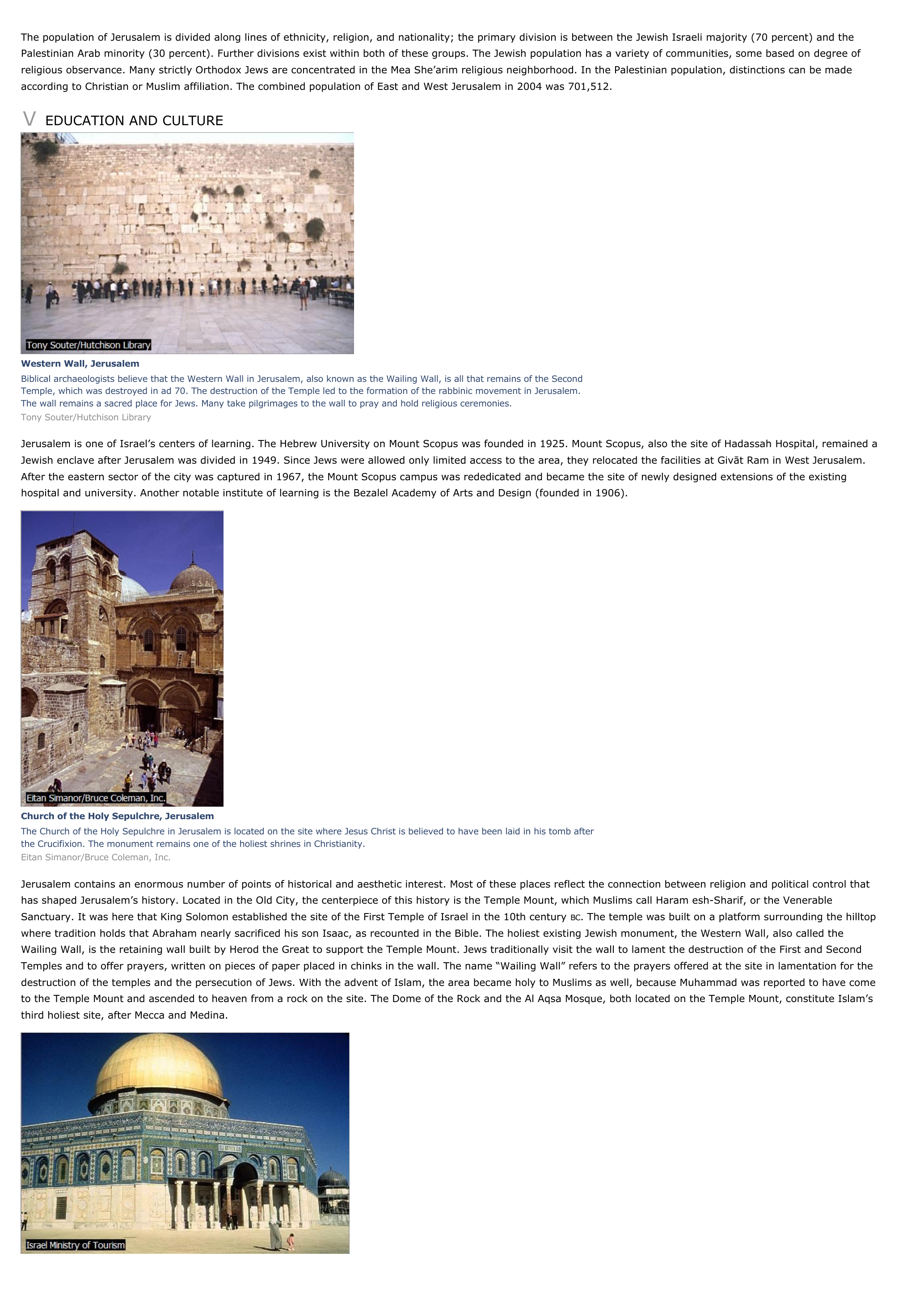Jerusalem - geography.
Publié le 27/05/2013
Extrait du document
«
The population of Jerusalem is divided along lines of ethnicity, religion, and nationality; the primary division is between the Jewish Israeli majority (70 percent) and thePalestinian Arab minority (30 percent).
Further divisions exist within both of these groups.
The Jewish population has a variety of communities, some based on degree ofreligious observance.
Many strictly Orthodox Jews are concentrated in the Mea She’arim religious neighborhood.
In the Palestinian population, distinctions can be madeaccording to Christian or Muslim affiliation.
The combined population of East and West Jerusalem in 2004 was 701,512.
V EDUCATION AND CULTURE
Western Wall, JerusalemBiblical archaeologists believe that the Western Wall in Jerusalem, also known as the Wailing Wall, is all that remains of the SecondTemple, which was destroyed in ad 70.
The destruction of the Temple led to the formation of the rabbinic movement in Jerusalem.The wall remains a sacred place for Jews.
Many take pilgrimages to the wall to pray and hold religious ceremonies.Tony Souter/Hutchison Library
Jerusalem is one of Israel’s centers of learning.
The Hebrew University on Mount Scopus was founded in 1925.
Mount Scopus, also the site of Hadassah Hospital, remained aJewish enclave after Jerusalem was divided in 1949.
Since Jews were allowed only limited access to the area, they relocated the facilities at Givāt Ram in West Jerusalem.After the eastern sector of the city was captured in 1967, the Mount Scopus campus was rededicated and became the site of newly designed extensions of the existinghospital and university.
Another notable institute of learning is the Bezalel Academy of Arts and Design (founded in 1906).
Church of the Holy Sepulchre, JerusalemThe Church of the Holy Sepulchre in Jerusalem is located on the site where Jesus Christ is believed to have been laid in his tomb afterthe Crucifixion.
The monument remains one of the holiest shrines in Christianity.Eitan Simanor/Bruce Coleman, Inc.
Jerusalem contains an enormous number of points of historical and aesthetic interest.
Most of these places reflect the connection between religion and political control thathas shaped Jerusalem’s history.
Located in the Old City, the centerpiece of this history is the Temple Mount, which Muslims call Haram esh-Sharif, or the VenerableSanctuary.
It was here that King Solomon established the site of the First Temple of Israel in the 10th century BC.
The temple was built on a platform surrounding the hilltop where tradition holds that Abraham nearly sacrificed his son Isaac, as recounted in the Bible.
The holiest existing Jewish monument, the Western Wall, also called theWailing Wall, is the retaining wall built by Herod the Great to support the Temple Mount.
Jews traditionally visit the wall to lament the destruction of the First and SecondTemples and to offer prayers, written on pieces of paper placed in chinks in the wall.
The name “Wailing Wall” refers to the prayers offered at the site in lamentation for thedestruction of the temples and the persecution of Jews.
With the advent of Islam, the area became holy to Muslims as well, because Muhammad was reported to have cometo the Temple Mount and ascended to heaven from a rock on the site.
The Dome of the Rock and the Al Aqsa Mosque, both located on the Temple Mount, constitute Islam’sthird holiest site, after Mecca and Medina..
»
↓↓↓ APERÇU DU DOCUMENT ↓↓↓
Liens utiles
- Jerusalem - geography.
- Tokyo - geography.
- Toronto - geography.
- Venice (Italy) - geography.
- Vienna - geography.

































